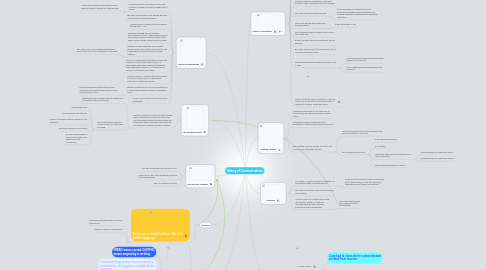
1. Hieroglyphics
1.1. Sixth Century BC
1.2. Hieroglyphics
1.2.1. HIERO means sacred, GLYPHIC means engraving or writing
1.2.2. a formal writing system that contained a combination of logograms and alphabetic elements
1.3. Books of the Dead
1.3.1. sets of scrolls of instructions and spells to help pharoahs find their way to the afterlife
1.4. 1798, France invades Egypt
1.4.1. Rosetta Stone is found
1.4.1.1. a slab with inscriptions on it, had same inscription written on it in three different languages
2. Cuniform
2.1. Sumerians created Cuniform , the first written language
2.1.1. created to help keep track of business transactions
2.1.2. began as a series of pictographs
3. The Phonetic Alphabet
3.1. one sign represented one spoken sound
3.2. gave rise to many other alphabets including the Latin alphabet
3.3. serif- a finishing off stroke
4. The Gutenberg Press
4.1. Johannes Gutenburg introduced the printing press, a hand press in which ink was rolled over the raised surface of movable hand-set letters held within a wooden frame, then the form was pressed against a sheet of paper.
4.1.1. Gutenberg is also credited with the invention of movable type and oil-based ink
4.1.2. The printing press impacted communication in many ways, including
4.1.2.1. It perfected script
4.1.2.2. economies became stronger
4.1.2.3. current information could be shared all over the world
4.1.2.4. population became more literate
4.1.2.5. art and science began to flourish which led to the beginning of the Renaissance
5. History of Photography
5.1. a camera obscura is an optical device that projects an image of its surroundings onto a screen
5.1.1. In the 17th and 18th centuries the camera obscura shrunk to the size of a portable box
5.2. the name "photography" was derived from the Greek words for light and writing
5.3. Joseph Niepce created the first successful photograph in 1827
5.4. Daguerre invented the first practical photographic process, called Daguerreotype, where they exposed a light-sensitive metal sheet, which created a direct positive image
5.5. William Fox Talbot invented the Calotype process, where the subject was exposed onto a light sensitive paper producing a paper negative
5.5.1. this is the basis of our modern photographic process because it uses negatives to duplicate
5.6. Archer is credited with the invention of the Wet Collodion Process (Wet Plate Process), in which glass plates were used for the negative and coated with collodion, a colorless syrupy solution of nitrocellulose in ether
5.7. Richard Maddox is credited with the invention of the Dry Plate Process, in which glass plates were coated with gelatin.
5.8. Eastman invented a roll film and manufactured a camera that brought cameras to the general public
5.8.1. Eastman established the Eastman Kodak Company and marketed the Brownie to the general public in 1900
5.9. James Clerk Maxwell took the first color photograph
6. Cave Paintings
6.1. Lascaux, France
6.1.1. Cave had to close due to carbon dioxide emitted from tourists
6.2. Altamira Cave
6.2.1. discovered by Marcelino Sanz de Saultuola
6.3. Chauvet Point d' Arc
6.3.1. Oldest known cave painting site
7. The Book
7.1. The codex, a covered and bound collection of handwritten pages, replaced papyrus
7.1.1. Codex able to be read at random access (any order), while papyrus could only be read in sequential access (order it was written)
7.2. The church used the codex format for Bibles and scripture
7.3. Scribes in the church wrote illuminated manuscripts, which are written by hand and adorned with elaborate illustrations and ornamentation
7.3.1. Illuminated manuscripts were replaced by the printing press
8. Linotype Machine
8.1. Chephane was looking for an easier way to transcribe his his notes an produce multiple copies
8.2. Christopher Sholes invented the only typewriter to become commercially successful
8.3. The Linotype machine allowed type to be set mechanically rather than by hand
8.3.1. The first Linotype machine was installed at The New York Tribune in July 1886
8.3.2. The Linotype machine had:
8.3.2.1. a 90-character keyboard
8.3.2.2. no shift key
8.3.2.3. uppercase letters had separate keys from lowercase letters
8.3.2.3.1. black keys were for lowercase letters
8.3.2.3.2. white keys were for uppercase letters
8.3.2.4. same alphabet arrangement twice
9. History of Computers
9.1. Konrad Zuse is credited with inventing the first freely programmable computer
9.2. The Mark series or computers were created for the US Navy for gunnery and ballistic calculations. They were designed by Howard Aiken and Grace Hooper
9.3. The first commercial computer was UNIVEC and was designed by John Preseper Eckert and John Mauchly. UNIVEC stands for Universal Automatic Computer
9.4. IBM stands for International Business Machines and they developed the ibm701 edpm computer
9.5. The first high level programming language was Fortran, which stands for IBM Formula Translating System
9.6. Douglas Engelbart invented the computer mouse to make computers more user friendly
9.7. The first internet was called Arpanet.
9.7.1. It was developed to protect the flow of information between military installations by creating a network of geographically separated computers
9.8. Intel 4004 was the first single chip microprocessor.
9.8.1. It was produced by Intel
9.9. IBM introduced the first memory disk, called the floppy disk
9.10. Robert Metcalfe and Xerox developed the first ethernet
9.11. Bill Gates and Microsoft introduced MS-DOS, a computer operating system
9.12. Apple introduced the computer, the Apple Lisa, in 1983
9.12.1. This was the first personal computer with a graphical user interface
9.12.2. Xerox created the first gui (graphical user interface)
